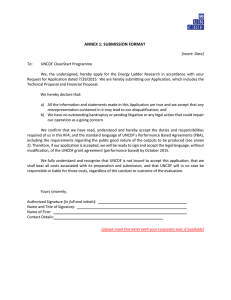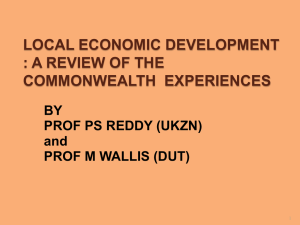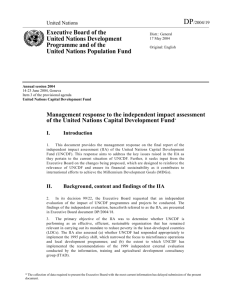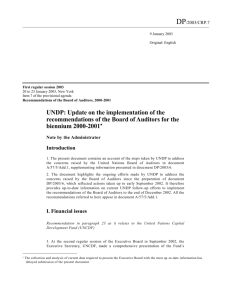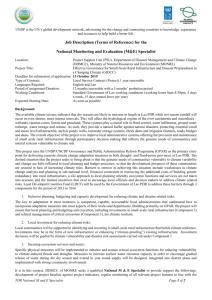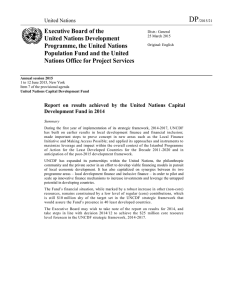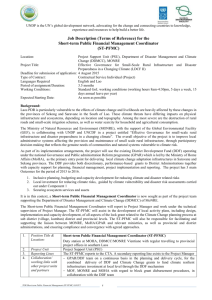UNCDF Integrated Results and Resources Matrix
advertisement
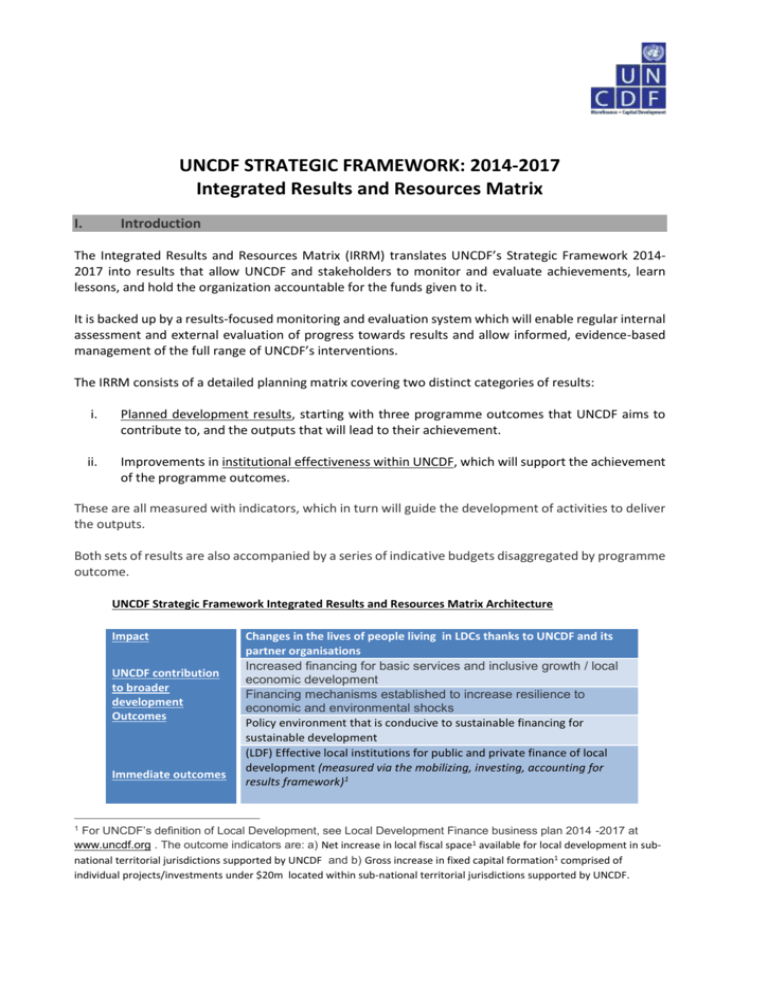
UNCDF STRATEGIC FRAMEWORK: 2014-2017
Integrated Results and Resources Matrix
I.
Introduction
The Integrated Results and Resources Matrix (IRRM) translates UNCDF’s Strategic Framework 20142017 into results that allow UNCDF and stakeholders to monitor and evaluate achievements, learn
lessons, and hold the organization accountable for the funds given to it.
It is backed up by a results-focused monitoring and evaluation system which will enable regular internal
assessment and external evaluation of progress towards results and allow informed, evidence-based
management of the full range of UNCDF’s interventions.
The IRRM consists of a detailed planning matrix covering two distinct categories of results:
i.
Planned development results, starting with three programme outcomes that UNCDF aims to
contribute to, and the outputs that will lead to their achievement.
ii.
Improvements in institutional effectiveness within UNCDF, which will support the achievement
of the programme outcomes.
These are all measured with indicators, which in turn will guide the development of activities to deliver
the outputs.
Both sets of results are also accompanied by a series of indicative budgets disaggregated by programme
outcome.
UNCDF Strategic Framework Integrated Results and Resources Matrix Architecture
Impact
UNCDF contribution
to broader
development
Outcomes
Immediate outcomes
Changes in the lives of people living in LDCs thanks to UNCDF and its
partner organisations
Increased financing for basic services and inclusive growth / local
economic development
Financing mechanisms established to increase resilience to
economic and environmental shocks
Policy environment that is conducive to sustainable financing for
sustainable development
(LDF) Effective local institutions for public and private finance of local
development (measured via the mobilizing, investing, accounting for
results framework)1
For UNCDF’s definition of Local Development, see Local Development Finance business plan 2014 -2017 at
www.uncdf.org . The outcome indicators are: a) Net increase in local fiscal space1 available for local development in subnational territorial jurisdictions supported by UNCDF and b) Gross increase in fixed capital formation1 comprised of
individual projects/investments under $20m located within sub-national territorial jurisdictions supported by UNCDF.
1
(FIPA) Sustainable, healthy FSPs leveraging UNCDF funds
(measured via range of MIX market indicators2)
Outputs
Institutional
Effectiveness
Completed technical assistance and provision of grants and loans to
UNCDF’s partner organisations in both the public and private sectors in
the Least Developed Countries
UNCDF is a more effective and efficient organization, with improved
systems and business practices and processes, well-managed resources
and engaged personnel
The foundation on which the IRRM is built has the following core elements:
1. Based on UNCDF’s broader theory of change set out in the Strategic Framework, the results in
the IRRM are intended to capture elements of development change that are most relevant to
UNCDF’s work across its two Programme Areas as well as intended changes in the organisation’s
internal capacity to allow UNCDF to deliver on its programmatic commitments.
2. The IRRM is organized according to three levels of intended development results: i) UNCDF’s
outputs in terms of completed technical assistance and grants and credits to UNCDF’s partner
organisations in the least developed countries; ii) the immediate results of this assistance in
terms of more effectively-functioning local institutions for local and public private finance as
well as sustainable financial service providers leveraging UNCDF funds and iii) UNCDF’s
contribution together with relevant partner organisations to three broader development
objectives: i) increased financing for basic services and sustainable inclusive growth; ii) new
financing mechanisms to increase resilience to economic and environmental shocks and iii) an
improved policy environment which is conducive to sustainable financing for sustainable
development.
In addition, the IRRM is intended to show clearly how strengthened internal capacity and
capability will allow UNCDF to deliver on its programmatic commitments; how the
commitments will be achieved and how these will contribute to the work of partner UN entities
as well as to overall internationally-agreed development goals.
3. The IRRM will assist UNCDF in monitoring and evaluating the results of its interventions at
different points in the results chain, allowing partners to understand the breadth, scope and
resource requirements of the work of the organization. In turn, it enables Member States and
other partners to see what outcomes and impact the organization is ultimately contributing to.
4.
The performance indicators capture to the extent possible data points that are already collected
and are based on years of good development practice and/or best available knowledge. This is
2
For FIPA, the MIX Market will capture a significant portion, but not all of the performance indicators required.
FIPA programmes may need to construct parallel sets of indicators and reporting frameworks to capture the
quantitative and qualitative data that are not standard MIX indicators (e.g. for large commercial banks that are
piloting downmarket and the lower segments only represent a small percentage of their total portfolio and may
not report on the MIX). Also, even for FSPs where the majority of their portfolio is ‘microfinance’ and they
should be required to report to the MIX so UNCDF can track their overall performance, the MIX Market does not
easily capture the portfolio of a specific innovation UNCDF is financing, e.g. CleanStart’s clean energy portfolio).
For Savings Groups (SG), UNCDF requires reporting to SAVIX on standard SG indicators. For more information on
the MIX Market, please see: http://www.mixmarket.org/
2
the case for example of indicators measuring changes in performance of financial service
providers which are collected externally by the MicroFinance Information Exchange.
5. The projected results depend on the organisation receiving the resources set out in the sections
below. These projected resources are estimated based on projected future demand by
programme countries and partners (using past expenditure as a guide) for products and services
provided by UNCDF and income projections for the period of 2014-2017. The amounts are
indicative only.
6. An accompanying methodological note to the IRRM has been produced and and explains how
each group of indicators will be measured against baseline and projected targets for 2017. In
doing so, UNCDF will attempt where possible to disaggregate data by different variables of
interest (for example: gender, geographical region, type of intervention etc). In some cases
where indicators are new, baseline figures ares still to be defined. These will be added in the
coming months.
7. Monitoring and reporting against indicators will be supported by a range of data sources and
evidence, using a mixed-methods approach of quantitative and qualitative measurement.
Internal monitoring will be complemented and validated by a results-focused system of
qualitative internal self-evaluation and external programme and outcome evaluation. This
integrated system of performance measurement will allow regular update on progress towards
results and allow informed and evidence-based management of the full range of UNCDF’s
interventions.
8. Finally in line with UNCDF’s commitment to continuous improvement, the Strategic Framework
itself will be subject to a formal mid-term review halfway through its implementation and an
independent evaluation will be carried out at the end of the period to provide lessons learned
and to inform strategic decision making ahead of the next programming improvement.
3
`
Outcomes and Outputs 3
II.
Part A - Development Effectiveness
Outcome 1: Financing increased for basic services and inclusive growth/local economic development
Indicative
resources4:
$ 117 million
Outcome Indicators: (assess progress against specified outcomes; they help verify that the intended positive
change in the development situation has actually taken place)
Baselines (2013,
unless noted)
Inclusive finance
10 to 1 leverage
of UNCDF’s core
resources
1.a. Net change of domestic savings mobilized by UNCDF-supported Financial Service Providers (FSPs)5
TBA7
Local Development Finance
3
Results for
2014
36 to 1
Targets (2017,
unless noted)
10 to 1 leverage of
UNCDF’s core
resources
75% of UNCDFsupported
institutions
indicating an
It should be noted that the targeted development and institutional results that are projected below depend on the organisation’s projected targets for core and non-core
resources of $25 million and $75 million being achieved on an annual basis by 2016.
4
Indicative resources for the four-year planning period are calculated as follows: from a total projected core starting at $16 million in 2014, moving to $20 million in 2015,
and culminating in $25 million in 2016 and 2017, applying a targeted ratio of 1:3 core to non –core as set out in Indicators 1.2.1, 1.2.2 and 1.2.3 in the section Institutional
Effectiveness yields a total projected envelope of $344 million resources available for development activities and institutional activities. Leaving aside 15% of this for
management costs as per Indicator 1.2.6, the remaining amount of 292.4 million is split between the three development outcomes on a 40:40:20 basis. These targets and
ratios will be revised if necessary following the end of the mid-term review of the Strategic Framework.
5
Financial Service Providers (FSPs) include a range of institutions, including but not limited to: commercial banks, Non-bank financial institutions (NBFIs), credit unions,
NGO-MFIs, Mobile Network Operators (MNOs), money transfer companies, and also service providers that use ‘pay as you go’ financing models to provide their products,
e.g. clean energy.
7
As these are completely new indicators, baselines are still being calculated.
4
`
1.b. Net increase in local fiscal space6 available for local development in sub-national territorial jurisdictions
supported by UNCDF
1.c. Gross increase in fixed capital formation8 comprised of individual projects/investments under $20m
located within sub-national territorial jurisdictions supported by UNCDF
6
increase in fiscal
space of over 25%
TBA9
30% increase in
fixed capital
formation in
UNCDF-supported
jurisdictions by
2017
Fiscal space is defined as “the sum of financial resources available for improved delivery of basic social and economic services at the local level as a result of the budget
and related decisions by governments at all levels without any prejudice to the sustainability of a governments financial position”. Source: International Monetary Fund,
Finance and Development, Vol. 42/2, Back to Basics – Fiscal Space: What is it and How to Get it?, Peter Heller
8
Gross fixed capital formation is defined as in the UN System of National Accounts applied by the IMF, World Bank and United Nations institutions. UNCDF adapts this
indicators to the local level. See System of National Accounts, United Nations 2008
9
As these are completely new indicators, baselines are still being calculated.
5
`
Outputs
specific
support established
Output to
Indicators
indicators
measure
those
Baselines
Outcome
2: (UNCDF
Effectiveprovides
financing
mechanisms
increase(output
resilience
to economic
andonly
environmental
shocks
results from schemes, services, plans, actions, etc., which are (2013, unless
for the following results)
specifically supported by UNCDF.)
noted)
Results for 2014 Indicative
Targets (2017,
unless noted)
resources:
$117 million
Inclusive finance
Outcome Indicators
Output 1.1
Financing for development: effect of UNCDF core funding
on resources for inclusive finance
Baselines (2013,
unless noted)
1.1.1 Change from baseline in value of loan portfolio of FSPs
Leverage
Improved
performance
of sustainable,
Inclusive
Finance
Programme
Area
(numerator) leveraged by UNCDF core contribution
UNCDF core
healthy, responsible FSPs leveraging UNCDF (denominator).
resources by a
2.a. funds
Number
products
to improve
(to of
benew
measured
in terms
of client security, resilience against shocks, and extend the frontiers of 45
factor of 10
inclusive
finance portfolio quality, outreach,
sustainability,
responsible provision of financial services))
1.1.2 Change from baseline in value of savings portfolio of
Leverage
FSPs (numerator) leveraged by total UNCDF core
UNCDF core
0 (for new
2.b. Number of clients served by these new products (see Outputs 2.1.1 – 2.1.4 for details)
resources by a
contribution (denominator).
products)
factor of 10
Sustainability: Improvements in FSP
Local Development Financing Programme Area profitability/sustainability. Improvements in portfolio
quality
2.c. Number of public and private financing systems (designed and piloted) for local infrastructure and
1.1.3and
- %their
of FSPs
that haveto
audited
statements
services that improves resilience of local governments
populations
shocksfinancial
(increasing
resilience of
20
populations, environment, built environment, productive systems)
1.1.4 - % of FSPs making progress toward profitability (return
on assets)
20
The indicator captures systems covered by global/national project documents signed from 1 January, 2014
6
0 (baseline is
zero as the
measure starts
81%
being counted at
the
beginning of
73%
2014 under the
new Strategic
Framework)
Results for
2014
56 to 1
48
36 to 1
1,031,167
served by new
products out of
total 4,982,232
clients reached
3 systems
being piloted
for Climate
90%
Change,
Food
Security and
75% Border
Cross
local
development
Targets (2017,
unless noted)
Leverage UNCDF
core resources
by a factor of 10
155 new products
(cumulative 2014
– 2017)
Leverage UNCDF
core resources
6,400,000
by a factor of 10
4 global
facilities/systems
in place for LDC
90%
financing of
climate
80% resilience,
food security and
two other issues
(to be decided)
through local
`
1.1.5 - % of FSPs meeting portfolio quality targets (PAR 30
days)
55%
59%
Responsibly-provided services:
1.1.6. - % of FSPs that endorse SMART Campaign Client
82%
Protection Principles (CPPs) or equivalent
Outputs (UNCDF provides
Output Indicators (output indicators measure only those results from schemes, Baselines (2013,
Improved performance of sustainable, accountable local
Local
Development
finance
specific support for the
services, plans, actions etc. which are specifically supported by UNCDF.
unless noted)
governments, and improved performance of revenue
following
results)
generating projects. Measured in terms of how UNCDF
Output
1.2
supports capacity to mobilize resources for effective
Indicator 2.2.1 - Total
numbers of active clients served via products that
Inclusive
finance
0
Improved
performance of sustainable,
local development.
strengthen
client resilience to shocks in areas such as client savings, Mobile
accountable local governments
and
2.1 Improved access to and
-a Change
in value
of total
national
5%
Money for the Poor1.2.1
(MM4P),
Betterfrom
Thanbaseline
Cash Alliance
(BTCA),
clean
energy,
improved performance of revenueusage of basic financial
budget allocated to local governments (leveraged by UNCDF
micro-insurance
generating projects. Measured
in terms of
services as an effective
contribution)
how UNCDF supports capacity to mobilize,
way to reduce
allocate, invest and make accountable
1.2.1 -b Change from baseline in own revenue mobilised by
5%
vulnerability and shocks
resources for effective local development.
local governments leveraged by UNCDF contribution
Local Development Finance
2.2 Improved access to and
usage of public and private
local investments as an
10
1.2.2. Change from baseline in value of domestic capital
mobilized
to the jurisdictions
local level (leveraged
UNCDF
2.2.2. Number of local
government
served byby
these
new systems
contribution)
as they are piloted and upscaled (see Outputs 2.1.1 – 2.1.4 for details)
Improved performance of sustainable, accountable local
governments, and improved performance of revenue
generating projects. Measured in terms of how UNCDF
10%
0
74%
governments
and
80%
local institutions
(cumulative total
2014 - 2017)
90%
Results for
2014
Targets (2017,
unless noted)
total 4,982,232
active clients
reached
12.2%10
6,400,000 new
clients benefiting
Leverage
UNCDF
from
resilient
core resources
financial
products
by awomen)
factor of 10
(50%
0.6511
8.5%
Over 100 in
piloting phase
for LoCAL,
Food Security
and cross
Leverage UNCDF
core resources
by a factor of 10
Leverage UNCDF
core
60%
of resources
LGs in
by
a
factor
of 10
upscaled
countries
Percentage increase in national budget allocated to Local Governments in jurisdictions receiving UNCDF support
11
This overall figure is an average across the portfolio and includes countries in which local governments do not yet mobilize significant own revenue. The figure does not reflect the notable
success in Bangladesh mentioned in the text.
7
`
effective way to reduce
vulnerability and shocks
border
collaboration
supports capacity to allocate resources for effective local
development.
1.2.3. Number of local institutions that improve performance
against selected PFM Indicators 12
PI13-8: Transparency of inter-governmental fiscal relations at the
sub-national level
57
5714
70% - % of LGs
covered by the
UNCDF
programme
12
70% - % of LGs
covered by the
UNCDF
programme
PI-12: Multi-year perspective in fiscal planning,
expenditure policy and budgeting
31
PI-19: Competition, value for money and controls in
public procurement
1.2.4. Number of investment projects reaching financial
closure following effective investment appraisal (LFI)15
23
0
10
1
70% - % of LGs
covered by the
UNCDF
programme
At least 15 per
country
12
Refers to the subset of PEFA sub-national indicators appropriate for measuring effective resource allocation processes calculated for institutions benefiting from UNCDF
support. See the methodological note for more information.
13
14
PI: Performance Indicator.
57 local governments performing at highest level measured by indicator.
15
Refers to revenue-generating projects appraised with support of LDFP staff including LFI Task Force and teams supporting municipalities establishing CIP portfolios for
municipal finance.
8
`
following three
years of
operation16
Output 1.2 Improved performance of sustainable,
accountable local governments, and improved
performance of revenue generating projects. Measured in
terms of how UNCDF supports capacity to invest
resources for effective local development.
1.2.6. Number and type of local investments in infrastructure
and services completed.
1500
1880,
Over 10,000 17
1.2.7. Number of UNCDF and / or local government
investments in supported revenue generating private and
public / private infrastructure and services complying with
financial projections.
7
3 (including LFI)
70% of projects
Output 1.2 Improved performance of sustainable,
accountable local governments, and improved
performance of revenue generating projects. Measured in
terms of how UNCDF supports capacity to make
accountable the resources that are invested in local
development.18
16
This is considered the critical mass to prove concept and enable scale up, which would lead to financing of many more projects.
These are exemplary investments in food security, climate resilience, women’s economic empowerment , service delivery and local economic development that trigger
further infrastructure through scaled up financing.
18
See methodological note for details of how to calculate these indicators, all refer to performance attributed to UNCDF initiatives.
17
9
`
1.2.8. Number of local institutions that improve performance
against accountability- related public financial management
indicators (PEFA)
100%19
75% of
institutions
supported
demonstrating
sustainable
improvements
in accountability
PI-10 Access to key fiscal information at the sub national level
refers to access of the general public at the location (‘local’
public access) or at least the relecant interest group
30
30
80% of LGs
supported by
UNCDF
programme
PI-11 Orderliness and participation in the annual budget
process
126
13 out of 126
80% of LGs
supported by
UNCDF
programme
1.2.9 Number of revenue generating projects with multi
stakeholder boards
7
7
Over 60%
Outcome 3: Policy environments fostered that enable sustainable financing for development
Indicative resources: $ 48 million
19
For PI-10: Access to key fiscal information at the sub-national level refers to access of the general public at the location ('local' public access) or at least the relevant
interest group
10
`
Outcome Indicators
Baselines
(2013, unless
noted)
Results for
2014
Targets (2017, unless noted)
Inclusive Finance
15
3. a. Number of improvements to the policy environment and enabling ecosystem, including
client protection, resulting from UNCDF advocacy and support.
11
85 (cumulative 2014 – 2017)
3. b. Policy environments fostered that enable increased financing for local development (public
and private)
0
421
75% of LDCs adopting enabling
policy environments for local
development
Outputs (UNCDF provides specific support for
the following results)
Output Indicators (output indicators measure
only those results from schemes, services,
plans, actions etc. which are specifically
supported by UNCDF).
Baselines
(2013, unless
noted)
Results for
2014
Targets (2017, unless noted)
Output 3.1 UNCDF- funded diagnostic
tools/advocacy initatitives provide a key
contribution to shaping national governments’
agendas on financial inclusion
3.1.1 Number of diagnostics on financial
inclusion completed 22
22
19
55 (cumulative 2014 – 2017)
Local Development Finance
Lesotho, Mali, Niger and the Lao People’s Democratic Republic
22 Examples of what FIPA would report on (cumulative and annual net change): Diagnostics( each country diagnostic: MAP diagnostic: market information; BTCA country
digital payment ecosystems improved directly via BTCA initiatives; BTCA: incremental Net Present Value (NPV) of economy-wide electronic payments as encouraged by
BTCA; MM4P diagnostic:: indentifies activities, initiatives or changes are needed to build more inclusive digital financial services (DFS) ecosystem that is sustainable,
affordable and reaches the majority of the population with basic financial services; Financial Diaries that contribute to policy-makers and FSPs understanding of client
demand and constraints; Market studies at province or district levels to help commercial banks and MFIs to invest in underseved areas with potential)
21
11
`
Output 3.2: UNCDF-funded diagnostic
tools/advocacy initiative provide a key
3.1.2 Number of inclusive finance road maps,
action plans or national strategies adopted23
6
8
35 (cumulative 2014 – 2017)
3.1.3. Number of commitments to the Better
than Cash Alliance24 to transition cash to
electronic payments
4
35
35 (Cumulative 2014 – 2017)
3.1.4 Number of capacity building activities
completed to strengthen the capacity of
regulators and supervisors, especially to
safeguard poor people’s savings
15
52
115 (cumulative 2014- 2017)
3.1.5. Number and quality of approved UNCDF 19
publications (inclusive finance)
62
130 (cumulative 2014 – 2017)
3.2.1 Number of local development
diagnostics completed25
80
20 LOOKING diagnostics (cumulative
2014 – 2017)
2
23 As a result of UNCDF-led diagnostics (MAP, MM4P, BTCA) that strengthen the capacity of national institutions to meet regional and international goals – e.g. Maya
Declaration or the Money Pacific Goals.
24 Please see www.betterthancash.org for further information
25
Examples of what LDFP would report on (cumulative and annual net change): Diagnostics (each country diagnostic: LOOKING diagnostic: LAFIAS diagnostic; diagnostic
of municipal creditworthiness; diagnostic of fiscal decentralisation status; local fiscal space diagnostic; scan of local infrastructure financing market, local procurement
diagnostic, local economic development study; diagnostic to define performance based grants criteria; study of local food system; LoCAL scoping study).
12
`
contribution to shaping national governments’
agendas in local development finance
75% of LDCs adopting UNCDFinspired strategies, plans and
regulatory changes in 10 approved
publications on local development
(cumulative 2014 – 2017)
3.2.2 Number of national strategies or action
plans for local development adopted26
2
36
75% of LDCs adopting UNCDFinspired strategies, plans and
regulatory changes in 10 approved
publications on local development
(cumulative 2014 – 2017)
3.2.3. Number of policy or regulatory changes
on local development finance as a result of
UNCDF advocacy on Local Development
Finance
0
5
75% of LDCs adopting UNCDFinspired strategies, plans and
regulatory changes in 10 approved
publications on local development
(cumulative 2014 – 2017)
3.2.4. Number of initiatives to strengthen
capacities of national and local actors
(training, advocacy, peer to peer learning)
0
25
200 (cumulative 2014 – 2017)
3.2.5 Number and quality of approved UNCDF
publications (local development)
0
0
12 (cumulative 2014 – 2017)
26 As a result of UNCDF-led diagnostics (LOOKING, LAFIAS, Municipal Finance) or as a result of upscaling such as a LoCAL phase III. These strengthen the capacity of local
institutions to secure access to sustainable finance for local investments and local development that accelerates SDC targets and increases local fiscal space.
13
`
14
`
Part B - Institutional Effectiveness
Indicative
resources:
$52 million
Baselines (2013,
unless noted)
Results for
2014
Targets (2017,
unless noted)
Not reported
70%
80%
1.1.2 Annual number of results-based evaluations (project, programme
and thematic)
3
4
6
1.1.3 Implementation rate of agreed actions in evaluation management
responses
70%
85.4%
80%
40%
42%
40%27
Result Statements
Indicators
Output 1.1 Improved quality
of programming and
accountability for results
Quality of Programming
1.1.1 Percentage of programme outcomes that are reported as on-track
or achieved
Evaluation and Accountability
Audit
1.1.4 Percentage of UNCDF’s programme covered by Office and Audit
Investigation (OAI)’s audit annually
27
As per UNCDF’s audit policy. Please see the methodological note for more information.
15
`
1.1.5 Percentage of audits that are unqualified
100%
100%
100%
1.1.6 Implementation rate of agreed-upon audit recommendations
85%
56%28
100%
46%
40%
100%
1.2.1 Levels of core+
$16 million
$14.9 million
$25 million
1.2.2 Levels of non-core (from development partners)
$35 million
$53 million
$55 million
1.2.3 Levels of non-core (from private and non-governmental sources)
$13 million
$20 million
$20 million
1.2.4 % delivery against approved budget
85%
76 %
90%
1.2.5 Optimal mobilisation ratio of non-core resources by core funds for
programmes/projects
3:1
5:1
4:1
15%
14%
15%
1.1.7 Gender Mainstreaming
Percentage compliance by UNCDF in at least ‘meeting’ UN System-Wide
Action Plan gender reporting requirements across the 15 performance
categories
Output 1.2 Structure of
financial resources
maximized
Total Resources Mobilized
Optimised Cost Structure
1.2.6 Percentage of total UNCDF expenditure related to management
activities (management- efficiency ratio)
28
UNCDF is working closely with UNDP to finalize the outstanding recommendations as the Loan policy, RBM and performance indicators and enterprise wide risk
management platform. We expect to achieve the completion of these recommendation during the next quarte
16
`
1.2.7 Percentage of total UNCDF expenditure on management activities
spent on travel costs
10%
2%
10%
Percentage of total resources going to capital grants:
1.2.8
Core
30%
17%
40%
1.2.9
Non-Core
44%
51%
50%
1.3.1 At all levels
27%
45%
50%
Output 1.3 Strengthened
human resource
management to attract,
develop and retain a
diversified and productive
workforce
1.3 Percentage of staff who are female
1.3.2 At P5 and above
28%
30%
50%
Output 1.4 Improved
perception of staff working
in UNCDF
1.4.1 Percentage of staff surveyed who expressed confidence in
leadership and direction
70%
64%
75%
1.4.2 Empowerment
66%
67%
75%
1.4.3 Engagement
67%
67%
75%
Output 1.5 Stronger
corporate positioning based
on robust internal policies,
rigorous analytical work,
active engagement in multi-
Percentage of staff surveyed who rate UNCDF favorably on:
1.5.1 Number of multi-partner initiatives in which UNCDF is involved
globally or regionally where the organisation can influence debate and
policy on the basis of its investment mandate (e.g. Inclusive Finance: cash 7
to electronic payments; responsible digital finance; youth financial
services; client protection; Local Development Finance: climate finance,
17
5 LD
9 FIPA
10 (cumulative
2014 – 2017)
`
lateral processes (including
post-2015) and effective
corporate KM
Output 1.6 UNCDF’s
mandate in the LDCs better
understand and more
widely- communicated to
target audiences based on
implementation of its
communications plans
Output 1.7 Partnerships
strategy implemented with
a view to extending the
scale and scope of UNCDF’s
work
29
30
decentralisation and local governance; strengthened productive capacity
at the local level)
1.6.1 Number of monthly unique vistors to public external website –
www.uncdf.org
≈ 6,000
8,392
≈ 10,000
1.6.2 Number of followers on Twitter corporate account
≈ 200
1,430
≈ 5,000
1.6.3 Number of followers on Facebook corporate account
≈ 500
94,569
≈ 30,000
1.7.1 Number of strategic partnerships effectively managed – and new
ones developed – leading to contributions to UNCDF core resources
12
1529
18
1.7.2 Number of strategic partnerships effectively managed – and new
ones developed – leading to contributions to UNCDF non-core resources
1.7.3 Number of UNCDF Stakeholder Consultations (informal Executive
Board sessions) arranged per year
25
3130
35
2
1
2
This includes contribution from UNDP to core resources.
Includes partnerships with individual partnerships leading to the MPTF at the country level (MPTF is disaggregated).
18
`
19
